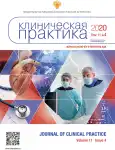Rapidly progressive course of nonspecific aortoarteritis: a clinical case
- Authors: Grushina M.V.1, Grekov I.S.1, Arkhypova K.D.1
-
Affiliations:
- M. Gorky Donetsk National Medical University
- Issue: Vol 11, No 4 (2020)
- Pages: 83-89
- Section: Case reports
- URL: https://journals.rcsi.science/clinpractice/article/view/54587
- DOI: https://doi.org/10.17816/clinpract54587
- ID: 54587
Cite item
Abstract
Background. Nonspecific aortoarteritis, or Takayasu’s disease, is one of the most complex and rare pathologies in modern clinical practice. It is the orphan nature of the disease, along with non-specific clinical manifestations, that causes a large number of clinical and diagnostic errors that lead to an unfavorable prognosis and early disability of patients. Despite the development of modern methods of treatment of nonspecific aortoarteritis, in some cases it is not possible to achieve a stable remission, which leads to a steady progression of the pathological process. Clinical case description. The article presents a case of a rapidly progressing course of Takayasu's disease in a young woman with multiple arterial vascular lesions that developed during the first year after the onset of arterial hypertension, while the narrowing of the carotid arteries (75–85%) was not accompanied by signs of cerebral ischemia. The follow-up period was 10 years. Conclusion. Given the peculiarities of this nosology, each identified case of Takayasu’s disease is of great clinical and practical interest. The disease peculiarity in thise patient is that during the first year from the onset of arterial hypertension, the main occlusive lesions of the aorta and arterial vessels were identified. At the same time, the narrowing of the carotid arteries (75–85%) was not accompanied by signs of cerebral ischemia. It should be noted that often the symptoms of non-specific aortoarteritis appear under the “masks” of other diseases, which requires a careful differential search. A correct diagnosis and timely treatment can prevent the development of complications and slow the progression of the disease.
Full Text
##article.viewOnOriginalSite##About the authors
Marina V. Grushina
M. Gorky Donetsk National Medical University
Email: grushinamarina@inbox.ru
ORCID iD: 0000-0003-3670-3376
MD, PhD, Associate professor
Ukraine, DonetskIlya Sergeevich Grekov
M. Gorky Donetsk National Medical University
Author for correspondence.
Email: ilya.grekov.1998@gmail.com
ORCID iD: 0000-0002-6140-5760
6th year student
Ukraine, DonetskKseniya D. Arkhypova
M. Gorky Donetsk National Medical University
Email: Ksena.LE@mail.ru
ORCID iD: 0000-0002-5344-2561
5th year student
Ukraine, DonetskReferences
- Мельник М.В., Шилов А.М., Уваровская Б.В., и др. К вопросу ранней диагностики болезни Такаясу (описание клинического случая) // Анестезиология и реаниматология. — 2014. — Т. 59. — № 6. — С. 52–56.[Mel’nik MV, Shilov AM, Uvarovskaya BV, et al. Early diagnosis of takayasu’s disease (clinical case report). Russian journal of anaesthesiology and reanimatology. 2014;59(6):52–56. (In Russ).]
- Скворцова Э.Н., ЗлобинаТ.И., КалягинА.Н., идр. Многолетнее наблюдение больной с неспецифическим аортоартериитом // Сибирский медицинский журнал. — 2006. — Т. 62. — № 4. — С. 83–86. [Skvortsova ЕN, Zlobina TI, Kalyagin AN, et al. Long-term supervision of the patient with nonspecific aortoarteriitis. Siberian Medical Journal (Irkutsk). 2006; 62(4):83–86. (In Russ).]
- Системные васкулиты в современной клинической практике /Под ред. А.И. Дядыка. — Донецк, 2013. — 248 с. [Sistemnye vaskulity v sovremennoi klinicheskoi praktike. Ed. by A.I. Dyadyka. Donetsk; 2013.248 р. (In Russ).]
- Гончарова Н.С., Самохвалова М.В., Пахомов А.В., и др. Артериит Такаясу. Обзор литературы // Артериальная гипертензия. — 2013. — Т. 19. — № 6. — С. 478–486. [Goncharova NS, Samohvalova MV, Pahomov AV, et al. Takayasu arteritis: a review. Arterial Hypertension. 2013;19(6):478–486. (In Russ).] doi: 10.18705/1607-419X-2013-19-6-478-476.
- Miller DV. The pathology of large-vessel vasculitides. Clin Exp Rheumatol. 2011;29:92–98.
- Weyand CM. Medium- and large-vessel vasculitis. N Engl J Med. 2013;349:161–165.
Supplementary files









